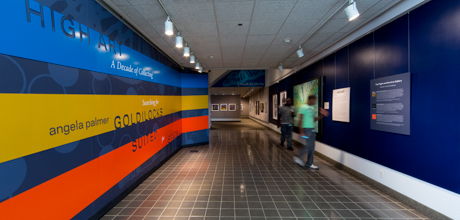Three new exhibits at the Smithsonian National Air and Space Museum (NASM) that explore flight gave 17 George Washington University graduate students a chance to watch their own design talents take off.
The students were part of Advanced Museum Exhibition Design, a course taught by Barbara Brennan, a professorial lecturer in GW’s Museum Studies program. The group worked on “High Art: A Decade of Collecting,” which features 50 pieces of art acquired by NASM; “Suited for Space,” a series of images about the evolution of spacesuits; and “Searching for Goldilocks,” a glass sculpture made by Angela Palmer, depicting planets identified by NASA’s Kepler Observatory for their similarities to Earth. The shows opened to the public on Friday in NASM’s Flight and Art Gallery, and they will run through Dec. 1.
Ms. Brennan is deeply connected to NASM—her work leading the exhibit design department spanned two decades. After retiring last year, she’s maintained close ties with the museum’s staff and approached them about allowing her advanced students to participate in a real public installation. The museum was on board, and soon students were working closely with professional curators.
“It was a win-win for everyone,” Ms. Brennan explained. “It was a wonderful experience for the students, and it helped the museum with its workload.”
This isn’t the first time Ms. Brennan’s classes have given students real-world design experience: She regularly teaches an Introduction to Design class, through which students also have the opportunity to do work for NASM. Earlier this summer, she led the Museum Exhibition Design Institute as they put together “Coming Soon,” an exhibit about the George Washington University’s forthcoming museum.
But her advanced class was intended to challenge more experienced designers, and the group quickly learned the difficulties of putting together three entire exhibits.
“Most people have much more time—even years—for an exhibit. We had one semester. Learning how much time each step takes and how to get all the information you need is a huge takeaway,” said second-year museum studies student Megan O’Connell.
The class split into groups to tackle different elements. Some designed the layout of the exhibits, others focused on graphic panels and art labels, and a final team worked on the gallery entrance, outdoor signs and banners.
Julia Jacobs, M.A. ’13, would rush to NASM whenever she had a break from her internship at the Smithsonian National Museum of Natural History just blocks away. She sat in on weekly meetings with the museum directors and helped hang pieces once they were shipped to the gallery.
“One of the problems was because we are new designers, we were feeling our way around. Some of us didn’t realize how seriously the NASM team would take our designs,” she said.
While hanging the “High Art: A Decade of Collecting” exhibit, Ms. Jacobs noticed a problem. The dimensions of a print created by artist Fran Forman were different than her team had anticipated. “Parachutist Descending,” a vibrant image of a woman clad in a plum-colored gown surrounded by butterflies, was shorter in size and created a noticeable gap on the wall.
Ms. Jacobs urged the curators to move the painting, and got an instant lesson in the difficulties of manipulating final exhibit designs.
“That was a really cool learning experience because you think it’s not a big deal to switch two paintings. But once the designs are signed off, you can’t swap things unless you’re the curator or the director,” she said. “Eventually, everything got fixed, but it was important to see how careful you need to be when laying things out and measuring. It was a frustrating process seeing how a millimeter on a piece of paper transfers into five inches of blank space on a wall.”
At an opening event last Wednesday, the students were able to enjoy the results of their work for the first time. They observed each element they’d pored over, from banners to bold graphics. The brilliant orange, yellow and blue color palettes first-year student Michelle Mazzuchi worked on greeted her from the museum’s entrance. Shadow images second-year student Caitlin Gillis drafted accented each exhibit perfectly. Ms. Jacobs walked through the halls, eyeing every painting from the exact positions she’d help choose on the walls.
“After being in this process, I feel really confident in my abilities—this has really bolstered my confidence, my resume and my portfolio,” Ms. Jacobs said.


